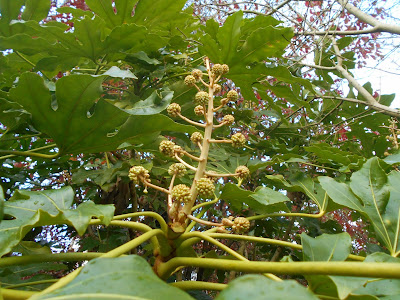The early promise turned out to be a deception. True, it wasn't windy or wet but, even though I was well wrapped up it was distinctly cold. Things were again looking miserable, the landscape grisaille-like. True, a brave Red Campion was doing its best to brighten things up but it had little support. George Gulliver collected the species near Banbury sometime between 1818 and 1824 (perhaps in Northamptonshire) and there are old records from Byfield and Charwelton, all probably on slightly acid soil.
 |
Red Campion often produces the odd, speculative late flower.
Foxhill Farm near Badby. 26 November, 2018
|
Arriving at Foxhill Farm I made my way towards a grove of Western Hemlock, Tsuga heterophylla, which looked promising. I should have known better. Little was found until I began lifting pieces of loose bark. I was interested to find that a specimen of Diaea dorsata had taken refuge there. With prey likely to be virtually absent over the next few months I suppose it was just sitting it out until the spring. In the gloom beneath the trees and using an unfamiliar camera I couldn't get a satisfactory shot.
 |
Loose bark was providing a refuge for this Diaea dorsata. Foxhill Farm, Badby, Northants.
26 November, 2018
|
Also beneath the bark were several female Amaurobius fenestralis. Unlike the Diaea this was to be expected for crevices of this kind form its normal habitat. A virtually identical species is found around our houses, again occupying crevices. This is Amaurobius similis and, if you discover one when you open your window, it is unlikely to be fenestralis, despite the name, but similis. Using an organ called the cribellum these species produce a bluish, woolly silk, and any creature struggling to free itself from this material usually becomes more and more enmeshed. The two species can only be reliably identified by examining the epigyne, i.e. the outer, exposed part of the female genitalia, or the palps of the male. The same camera problem persisted.
Although the woodland was general disappointing there was one surprise. By beating a clump of ivy I dislodged a Juniper Shieldbug, Cyphostethus tristriatus. It is not rare but to find it on ivy is most unusual, and it is new to Foxhill Farm, bringing the total there to 436 species. With its amber, boomerang-shaped marking this species, once a great rarity, is very distinctive.
 |
A Juniper Shieldug was a surprise and a new record for Foxhill Farm.
26 November, 2018
|
I had kept my eyes open for fungi. They're really not my bag (as Jacob Rees-Mogg would say) but I do manage to recognise a handful. One of these is the Candlesnuff Fungus, Xylaria hypoxylon. Another name is, for rather obvious reasons, Carbon Antlers.
 |
Candlesnuff fungus is likely to be encountered on a
winter woodland walk. 16 November, 2018
|
As I plucked a few for photographing, a white cloud of spores drifted away on the light breeze. In the spring these are replaced by black spores. It is common on decaying logs, especially in damp woodland and often in gloomy situations.
So, the morning was not a waste of time and overall I was pleased with my findings, meagre though they were.















































